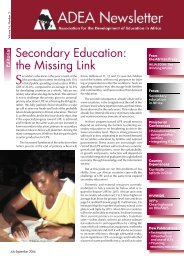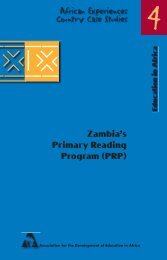Trends in Distance Education and Open Learning: Policy ... - ADEA
Trends in Distance Education and Open Learning: Policy ... - ADEA
Trends in Distance Education and Open Learning: Policy ... - ADEA
Create successful ePaper yourself
Turn your PDF publications into a flip-book with our unique Google optimized e-Paper software.
education free <strong>and</strong> elementary education compulsory 4 ? It is advocated that DEOL canhelp.There have been several phases <strong>in</strong> the development of onl<strong>in</strong>e-learn<strong>in</strong>g. The first phasewas closely related to establishment of the Computer Based Tra<strong>in</strong><strong>in</strong>g Systems created<strong>in</strong> 1984 which was followed by the CD-ROMs that were used to tra<strong>in</strong> people. In thesecond phase on-l<strong>in</strong>e learn<strong>in</strong>g was ma<strong>in</strong>ly concerned with the delivery of text-basedprogrammes with negligible web-based discussion <strong>and</strong> chat rooms. Use of email <strong>and</strong>the Internet focussed on <strong>in</strong>teraction through text-based exchanges that also allowed fileshar<strong>in</strong>g through attachments. In the present phase the focus is on virtual reality thatallow effective <strong>in</strong>teraction <strong>in</strong> virtual classrooms setups as well as on mobile telephonesfor ubiquitous distance education.The def<strong>in</strong>ition of e-learn<strong>in</strong>g has also evolved. In late 1997, learn<strong>in</strong>g guru Elliott Masie 5said, “Onl<strong>in</strong>e learn<strong>in</strong>g is the use of network technology to design, deliver, select,adm<strong>in</strong>ister, <strong>and</strong> extend learn<strong>in</strong>g.” In 1998, Jay Cross 4 wrote, “eLearn<strong>in</strong>g is learn<strong>in</strong>g onInternet Time, the convergence of learn<strong>in</strong>g <strong>and</strong> networks. E-Learn<strong>in</strong>g is a vision of whatcorporate tra<strong>in</strong><strong>in</strong>g can become. E-Learn<strong>in</strong>g is to traditional tra<strong>in</strong><strong>in</strong>g as e-Bus<strong>in</strong>ess is tobus<strong>in</strong>ess as usual.” In 1999, Cisco stated that, “eLearn<strong>in</strong>g is Internet-enabled learn<strong>in</strong>g.Components can <strong>in</strong>clude content delivery <strong>in</strong> multiple formats, management of thelearn<strong>in</strong>g experience, <strong>and</strong> a networked community of learners, content developers <strong>and</strong>experts.” Accord<strong>in</strong>g to Eke (2010), “e-learn<strong>in</strong>g is generally seen as either learn<strong>in</strong>g viathe Internet or any other electronic means or gadgets. E-learn<strong>in</strong>g comes <strong>in</strong> differentformats <strong>and</strong> categories.”Another noticeable change is that previously DEOL tutors were selected among thosetutor<strong>in</strong>g <strong>in</strong> conventional education who did not know much about the mechanics ofDEOL; however, currently we are witness<strong>in</strong>g an <strong>in</strong>creas<strong>in</strong>g number of professional DEOLexperts.4 http://www.un.org/Overview/rights.html5 Cross, J. (2004),” An <strong>in</strong>formal history of eLearn<strong>in</strong>g”, On the Horizon, Vol.12, No. 3, pp. 103-110.3
















